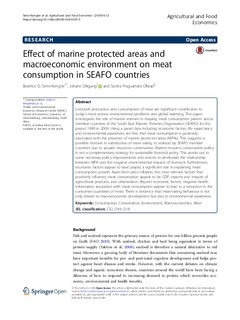| dc.contributor.author | Simo-Kengne, Beatrice D | |
| dc.contributor.author | Dikgang, Johane | |
| dc.contributor.author | Ofstad, Sunita P. | |
| dc.date.accessioned | 2019-09-10T06:10:15Z | |
| dc.date.available | 2019-09-10T06:10:15Z | |
| dc.date.created | 2018-12-20T16:39:09Z | |
| dc.date.issued | 2018 | |
| dc.identifier.citation | Agricultural and Food Economics (Agric. food econ.). 2018, 6 (12), 1-13. | nb_NO |
| dc.identifier.issn | 2193-7532 | |
| dc.identifier.uri | http://hdl.handle.net/11250/2614359 | |
| dc.description.abstract | Livestock production and consumption of meat are significant contributors to today’s most serious environmental problems and global warming. This paper investigates the role of marine reserves in shaping meat consumption pattern across member countries of the South East Atlantic Fisheries Organisation (SEAFO) for the period 1990 to 2009. Using a panel data including economic factors, life expectancy and environmental awareness, we find that meat consumption is positively associated with the presence of marine protected areas (MPAs). This suggests a possible increase in substitution of meat eating to seafood by SEAFO member countries due to aquatic resources conservation. Marine resource conservation policy is not a complementary strategy for sustainable livestock policy. This points out to some necessary policy improvements and actions to ameliorate the relationship between MPA and the negative environmental impacts of livestock. Furthermore, economic factors appear to have played a significant role in explaining meat consumption growth. Apart from price inflation, the most relevant factors that positively influence meat consumption appear to be GDP, exports and imports of agricultural products, and urbanisation. Beyond economic factors, negative health information associated with meat consumption appear to lead to a reduction in the consumed quantities of meat. There is evidence that meat-eating behaviour is not only related to macroeconomic development but also to environmental awareness. | nb_NO |
| dc.language.iso | eng | nb_NO |
| dc.publisher | Springer Verlag | nb_NO |
| dc.rights | Navngivelse 4.0 Internasjonal | * |
| dc.rights.uri | http://creativecommons.org/licenses/by/4.0/deed.no | * |
| dc.title | Effect of marine protected areas and macroeconomic environment on meat consumption in SEAFO countries | nb_NO |
| dc.type | Journal article | nb_NO |
| dc.type | Peer reviewed | nb_NO |
| dc.description.version | publishedVersion | nb_NO |
| dc.source.pagenumber | 1-13 | nb_NO |
| dc.source.volume | 6 | nb_NO |
| dc.source.journal | Agricultural and Food Economics (Agric. food econ.) | nb_NO |
| dc.source.issue | 12 | nb_NO |
| dc.identifier.doi | 10.1186/s40100-018-0105-5 | |
| dc.identifier.cristin | 1646445 | |
| dc.description.localcode | © The Author(s). 2018 Open Access This article is distributed under the terms of the Creative Commons Attribution 4.0 International License (http://creativecommons.org/licenses/by/4.0/) | nb_NO |
| cristin.unitcode | 194,67,40,0 | |
| cristin.unitname | Institutt for psykologi | |
| cristin.ispublished | true | |
| cristin.fulltext | original | |
| cristin.qualitycode | 1 | |

